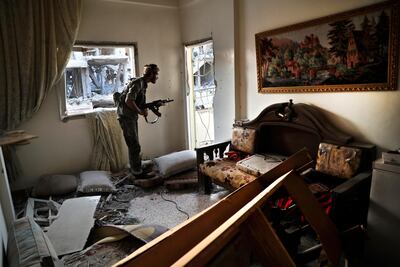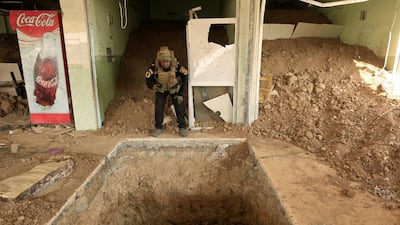The campaign to defeat ISIS in Iraq and Syria has slowed because the militants are using underground hideouts and cave complexes as staging points for attacks, the US-led coalition battling the group admitted on Sunday.
The evolving use of such guerrilla tactics represents a new challenge, officials said, and has prompted increased activity by the coalition and its ground partners to eradicate ISIS from the two countries.
Although territory held by the insurgents has severely diminished following the liberation of the two biggest Syrian and Iraqi cities once under its control, Raqqa and Mosul, the ability of the militants to hold out in unconventional ways appears part of a new and lethal underground insurgency.
Col Sean Ryan, spokesman for the coalition, told reporters that "Operation Roundup", an offensive to clear the last remnants of ISIS from its pockets in eastern Syria and the border region with Iraq, had been delayed by the insurgents' latest tactics.
The operation, now in its fourth month, has reduced a hostile 2,000 square kilometre desert area to just 200 square kilometres, but the push still faces stubborn resistance.
Led on the ground by the Arab-Kurdish coalition known as the Syrian Democratic Forces (SDF), it has been complicated by ISIS fighters hiding in tunnels prior to conducting attacks behind enemy lines. The militant burrows were once used by oil companies in the Syrian desert, strong structures that can withstand coalition vehicles driving over them.
"When [the SDF] started to clear the area, they were doing 30 to 50 kilometres a day, but then military intelligence established that Daesh was living underground and they may have well rolled over some of these tunnels,” Col Ryan said at a briefing in Abu Dhabi, using the Arabic acronym for ISIS.
"They went back and looked at how these fighters are getting behind us in some areas and that’s what they found out,” he said. “So now they are going through methodically and covering the areas and making sure there are no underground tunnels. If there is, they are destroying them."
ISIS has also left thousands of roadside bombs during its retreat. Whereas the US military once used mine-resistant military vehicles to withstand such hidden bombs in Iraq, the SDF does not have such a defence, so the campaign has become "slow-rolling", according to Col Ryan.
"You still have to plan defensively too, even though you're on the offensive now," he added.

In northern Iraq, ISIS fighters have reverted to an old Al Qaeda tactic used on the Afghanistan-Pakistan border: a retreat to caves. Many are now holed up in cave complexes in the Hamrin mountains near the Kurdish city of Kirkuk, which they can use to store weapons, plan attacks and avoid surveillance.
The Iraqi military and the coalition are using intelligence sources and air strikes in a bid to uproot or eliminate the fighters hiding there in a rural, largely unpopulated area that lacks roads.
"The Iraqis are... leading that effort," Col Ryan said when asked by The National if the coalition was striking the cave complexes, lauding Baghdad's efforts to lead the mission.
Col Ryan's predecessor Col Ryan Dillon confirmed to The National in a May interview that the coalition was assisting the Iraqi military with airstrikes.
"It's a relatively easy place for terrorists and criminals to hide out. In particular in this area, there are a lot of cave complexes that have been identified," he said at the time. "We have conducted several strikes against these cave complexes to absolutely destroy them so that they cannot be used to either hide or store weapons, ammunition, suicide belts".
_______________
Read more:
Gargash: Al Qaeda in Yemen is weaker than ever
ISIS cell in Iraq kills 5 members of a family
_______________
The strategy to retreat to caves, tunnels and other underground spaces was promoted by ISIS’s now-dead spokesman and foreign operations chief Abu Muhammad Al Adnani. In a May 2016 audio recording, he advocated a temporary retreat into the desert amid losses.
"This was to avoid war targeting," Hisham Al Hashimi, an expert on ISIS who advises the Iraqi government, told The National. Three battalions were tasked with leading the retreat operations: Syrians, Uzbeks and Uighurs, the Turkic ethnic group from eastern and central Asia.
"These operations allowed for 3,000 Syrian Daesh fighters and 2,000 Iraqi Daesh fighters to remain underground," he said.
Al Adnani warned that ISIS would never be defeated, even if it lost its vast tracts of territory, as the battle for the coalition, the SDF and the Iraqi security forces would not defeat the group's ideology.
"Whoever thinks that we fight to protect some land or some authority, or that victory is measured thereby, has strayed far from the truth," he said in the long audio clip addressed to his fellow militants.

